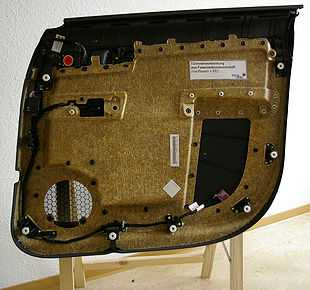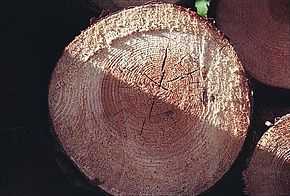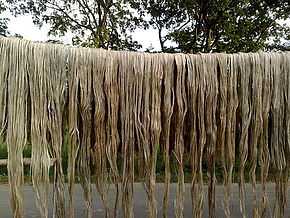Biocomposite

Biocomposite is a composite material formed by a matrix (resin) and a reinforcement of natural fibers. These kind of materials often mimic the structure of the living materials involved in the process keeping the strengthening properties of the matrix that was used, but always providing biocompatibility. The matrix phase is formed by polymers derived from renewable and nonrenewable resources. The matrix is important to protect the fibers from environmental degradation and mechanical damage, to hold the fibers together and to transfer the loads on it. In addition, biofibers are the principal components of biocomposites, which are derived from biological origins, for example fibers from crops (cotton, flax or hemp), recycled wood, waste paper, crop processing byproducts or regenerated cellulose fiber (viscose/rayon). The interest in biocomposites is rapidly growing in terms of their industrial applications (automobiles, railway coach, aerospace, military applications, construction, and packaging) and fundamental research, due to its great benefits (renewable, cheap, recyclable, and biodegradable).
Characteristics

The differential for this class of composites is that they are biodegradable and pollute the environment less, which is a concern for many scientists and engineers to minimize the environmental impact of the production of a composite. They are a renewable source, cheap, and in certain cases completely recyclable. One advantage of natural fibers is their low density, which results in a higher tensile strength and stiffness than glass fibers, besides of its lower manufacturing costs. As such, biocomposites could be a viable ecological alternative to carbon, glass and man-made fiber composites. Natural fibers have a hollow structure, which gives insulation against noise and heat. It is a class of materials that can be easily processed, and thus, they are suited to a wide range of applications, such as packaging, building (roof structure, bridge, window, door, green kitchen), automobiles, aerospace, military applications, electronics, consumer products and medical industry (prosthetic, bone plate, orthodontic archwire, total hip replacement, and composite screws and pins).
Classification
Biocomposites are divided into non-wood fibers and wood fibers, which all of them present cellulose and lignin. The non-wood fibers (natural fibers) are more attractive for the industry due to the physical and mechanical properties which they present. Also, these fibers are relatively long fibers, and present high cellulose content, which delivers a high tensile strength, and degree of cellulose crystallinity. Whereas, natural fibers have some disadvantages because they have hydroxyl groups (OH) in the fiber that can attract water molecules, and thus, the fiber might swell. This results in voids at the interface of the composite, which will affect the mechanical properties and loss in dimensional stability. The wood fibers have this name because almost than 60% of its mass is wood elements. It presents softwood fibers (long and flexible) and hardwood fibers (shorter and stiffer), and has low degree of cellulose crystallinity.

| Biocomposites/Biofibers | |||||||
|---|---|---|---|---|---|---|---|
| Non-Wood Natural Fibers | Wood Fibers | ||||||
| Straw Fibers | Bast | Leaf | Seed/Fruit | Grass Fibers | --------------- | Recycled | |
| Examples | |||||||
| Rice, Wheat, Corn Straws | Kenaf, flax, jute, hemp | Henequen, sisal, penneaple leaf fiber | Cotton, coir, coconut | Bamboo, bamboo fiber, switch grass, elephant grass | Soft and hard woods | Newspaper, magazine fibers | |
The natural fibers are divided into straw fibers, bast, leaf, seed or fruit, and grass fibers. The fibers most widely used in the industry are Jute, Hemp, Kenaf, Sisal and Coir. The straw fibers could be found in many parts of the world, and it is an example of a low-cost reinforcement for biocomposites. The wood fibers could be recycled or non-recycled. Thus, many polymers as polyethylene (PE), polypropylene (PP), and polyvinyl chloride (PVC) are being used in wood composites industries.
Green Composites
Green composite are classified as a biocomposite combined by natural fibers with biodegradable resins. They are called green composites, mainly because of their degradable and sustainable properties, which can be easily disposed without harming the environment. Because of its durability, green composites are mainly used to increase the life cycle of products with short life.
Hybrid Composites
Another class of biocomposite is called hybrid biocomposite which is based on different types of fibers into a single matrix. The fibers can be synthetic or natural, and can be randomly combined to generate the hybrid composites. Its functionality depends directly on the balance between the good and bad properties of each individual material used. Besides, with the use of a composite that has two more types of fibers in the hybrid composite, one fiber can stand on the other one when it is blocked. The properties of this biocomposite depends directly on the fibers counting their content, length, arrangement, and also the bonding to the matrix. In particular, the strength of the hybrid composite depends on the failure strain of the individual fibers.
Processing

The production of biocomposites uses techniques that are used to manufacture plastics or composites materials. These include:
- Machine press;
- Filament winding;
- Pultrusion;
- Extrusion (most widely used, principally for green biocomposite);
- Injection molding;
- Compression molding;
- Resin transfer molding;
- Sheet Moulding Compound.
Bibliography
- Pingle,P. Analytical Modeling of Hard Biocomposites. ProQuest, 2008. University of Massachusetts Lowell. Website: http://books.google.com/booksid=XRLEstOKTiEC&printsec=frontcover&dq=biocomposites&hl=ptBR&sa=X&ei=ie42VJT3Jva1sQTVm4DYDA&ved=0CEAQ6AEwBQ#v=onepage&q=biocomposites&f=false
- Mohanty, A.K.; Misra, M.; Drzal, L.T. Natural Fibers, Biopolymers, and Biocomposites. CRC Press, 2005. Website: http://books.google.com/booksid=AwXugfY2oc4C&dq=biocomposites&hl=ptBR&source=gbs_navlinks_s
- Averous, L.; Le Digabel, F. Properties of biocomposites based on lignocellulosic fillers. Science Direct, 2006. Website: http://www.biodeg.net/fichiers/Properties%20of%20biocomposites%20based%20on%20lignocellulosic%20fillers%20(Proof).pdf
- Averous, L. Cellulose-based biocomposites: comparison of different multiphasic systems. Composite Interfaces, 2007. Website: http://www.biodeg.net/fichiers/Cellulosebased%20biocomposites%20(Abstract-Proof).pdf
- Halonen, H. Structural changes during cellulose composite processing. Stockholm, 2012. Website: http://www.diva-portal.org/smash/get/diva2:565072/FULLTEXT01.pdf
- Fowler, P; Hughes, J; Elias, E. Biocomposites: technology, environmental credentials and market forces. Journal of the Science Food and Agriculture, 2006. Website: http://www.bc.bangor.ac.uk/_includes/docs/pdf/biocomposites%20technology.pdf